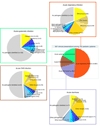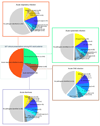Causes and outcomes of sepsis in southeast Asia: a multinational multicentre cross-sectional study
- PMID: 28104185
- PMCID: PMC5332551
- DOI: 10.1016/S2214-109X(17)30007-4
Causes and outcomes of sepsis in southeast Asia: a multinational multicentre cross-sectional study
Abstract
Background: Improved understanding of pathogens that cause sepsis would aid management and antimicrobial selection. In this study, we aimed to identify the causative pathogens of sepsis in southeast Asia.
Methods: In this multinational multicentre cross-sectional study of community-acquired sepsis and severe sepsis, we prospectively recruited children (age ≥30 days and <18 years) and adults (age ≥18 years) at 13 public hospitals in Indonesia (n=3), Thailand (n=4), and Vietnam (n=6). Hospitalised patients with suspected or documented community-acquired infection, with at least three diagnostic criteria for sepsis according to the Surviving Sepsis Campaign 2012, and within 24 h of admission were enrolled. Blood from every patient, and nasopharyngeal swab, urine, stool, and cerebrospinal fluid, if indicated, were collected for reference diagnostic tests to identify causative pathogens. We report causative pathogens of sepsis and 28-day mortality. We also estimate mortality associated with enrolment with severe sepsis. This study was registered with ClinicalTrials.gov, number NCT02157259.
Findings: From Dec 16, 2013, to Dec 14, 2015, 4736 patients were screened and 1578 patients (763 children and 815 adults) were enrolled. Dengue viruses (n=122 [8%]), Leptospira spp (n=95 [6%]), rickettsial pathogens (n=96 [6%]), Escherichia coli (n=76 [5%]), and influenza viruses (n=65 [4%]) were commonly identified in both age groups; whereas Plasmodium spp (n=12 [1%]) and Salmonella enterica serovar Typhi (n=3 [0·2%]) were rarely observed. Emerging pathogens identified included hantaviruses (n=28 [2%]), non-typhoidal Salmonella spp (n=21 [1%]), Streptococcus suis (n=18 [1%]), Acinetobacter spp (n=12 [1%]), and Burkholderia pseudomallei (n=5 [<1%]). 28-day mortality occurred in 14 (2%) of 731 children with known statuses and 108 (13%) of 804 adults. Severe sepsis was identified on enrolment in 194 (28%) of 731 children and 546 (68%) of 804 adults, and was associated with increased mortality (adjusted odds ratio 5·3, 95% CI 2·7-10·4; p<0·001).
Interpretation: Sepsis in southeast Asia is caused by a wide range of known and emerging pathogens, and is associated with substantial mortality.
Funding: National Cancer Institute, National Institute of Allergy and Infectious Diseases, National Institutes of Health, USA, and Wellcome Trust, UK.
Copyright © 2017 The Author(s). Published by Elsevier Ltd. This is an Open Access article under the CC BY 4.0 license. Published by Elsevier Ltd.. All rights reserved.
Conflict of interest statement
We declare that we have no conflicts of interest.
Figures





References
-
- Dellinger RP, Carlet JM, Masur H, et al. Surviving Sepsis Campaign guidelines for management of severe sepsis and septic shock. Intensive Care Med. 2004;30(4):536–555. - PubMed
-
- Dellinger RP, Levy MM, Carlet JM, et al. Surviving Sepsis Campaign: international guidelines for management of severe sepsis and septic shock: 2008. Crit Care Med. 2008;36(1):296–327. - PubMed
-
- D’Acremont V, Kilowoko M, Kyungu E, et al. Beyond malaria--causes of fever in outpatient Tanzanian children. N Engl J Med. 2014;370(9):809–817. - PubMed
-
- Farrar J, Hotez P, Junghanss T, Kang G, Lalloo DG, White N. Manson’s Tropical Infectious Diseases. 2014;23
Publication types
MeSH terms
Associated data
Grants and funding
LinkOut - more resources
Full Text Sources
Other Literature Sources
Medical
Research Materials
Miscellaneous

